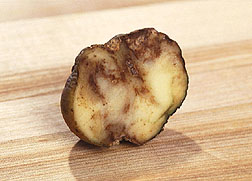This page has been archived and is being provided for reference purposes only. The page is no longer being updated, and therefore, links on the page may be invalid.
|
|
Bacteria Take on Late Blight, Sprouting and Dry Rot in Potatoes
By Jan SuszkiwSeptember 27, 2004
Spraying potatoes with harmless bacteria that delay sprouting and suppress dry rots may also shield the tubers from late blight disease, according to Agricultural Research Service scientists.
Patricia Slininger and David Schisler at the ARS National Center for Agricultural Utilization Research, Peoria, Ill., and colleagues patented methods for using 18 strains of Pseudomonas and Enterobacter bacteria to stymie postharvest sprouting and dry rot. Caused by the fungus Fusarium sambuciunum, dry rot costs $100 million in losses in stored potatoes, which comprise 70 percent of the nation's $3 billion tuber crop.
Recently, at annual meetings of the Society for Industrial Microbiology and the American Phytopathological Society, the scientists reported their discovery that the spray-on bacteria also stymie infection of stored spuds by Phytophthora infestans, the funguslike organism responsible for late blight. This disease is a worldwide threat, causing $400 million in losses in the U.S. potato crop alone. The emergence of fungicide-resistant strains of late blight has exacerbated the problem, according to Schisler, who is in the ARS center's Crop Bioprotection Research Unit.
To determine the beneficial bacteria's potential as a fungicide alternative, the Peoria team began by inoculating wounded potatoes with both the bacteria and an infectious-spore stage of late blight. After storing the potatoes for one week at 15 degrees Celsius and 90 percent relative humidity, the team checked the spuds for the telltale signs of late blight: a shrunken surface with irregular brown patches beneath. Their top bacterial "picks"--three strains of P. fluorescens and one of E. cloacae--reduced late blight by 25 to 65 percent.
In warehouse-simulation studies at the University of Idaho-Kimberly, the team sprayed boxes of potatoes with mixtures of late blight and the bacteria. In those studies, the bacteria curbed late blight by 35 to 91 percent.
The ARS team, together with University of Idaho scientists, will collaborate with a commercial firm to conduct further tests under a cooperative research and development agreement.
ARS is the U.S. Department of Agriculture's chief scientific research agency.

